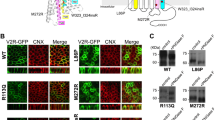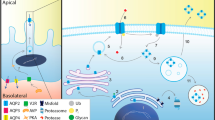Abstract
Nephrogenic diabetes insipidus (DIR) is an X–linked disorder characterized by insensitivity of the distal nephron for the pituitary hormone, vasopressin. The genetic map location of the DIR gene on chromosome Xq28 coincides with the physical map location of the functional vasopressin renal V2–type receptor. Recently, the human and rat cDNAs for the vasopressin V2 receptor (AVPR2) have been identified. We show here that the structural AVPR2 gene is localized between DXS52 and G6PD, which is within the genetic map location of DIR. We also tested eight X–linked DIR probands and their families for mutations in one of the most conserved extracellular regions ofAVPR2: in three of them, we have identified point mutations resulting in non–conservative amino acid substitutions which cosegregated with DIR in all families.
This is a preview of subscription content, access via your institution
Access options
Subscribe to this journal
Receive 12 print issues and online access
$209.00 per year
only $17.42 per issue
Buy this article
- Purchase on Springer Link
- Instant access to full article PDF
Prices may be subject to local taxes which are calculated during checkout
Similar content being viewed by others
References
Williams, R.H. & Henry, C. Nephrogenic diabetes insipidus: Transmitted by females and appearing during infancy in males. Ann. Intern. Med. 27, 84–95 (1947).
Reeves, W.B. & Andreoli, T.E. Nephrogenic diabetes insipidus. In The Metabolic Basis of Inherited Disease (eds Scriver, C.R. et al.) 1985–2011 (McGraw-Hill, New York, 1989).
Knoers, N. & Monnens, L.A.H., Clinical symptoms, pathogenesis, genetics and treatment. Pediatr. Nephrol. (in the press).
Jard, S. Vasopressin receptors. In Frontiers of Hormone Research. Vol. 13. Diabetes insipidus in man (eds Czernichow, P. & Robinson, A.G.) 89–104 (S. Karger. Basel, 1985).
Bichet, D.G. et al. Hemodynamic and coagulation responses to 1 -desamino[8-D-Arginine] vasopressin in patients with congenital nephrogenic diabetes insipidus. New Engl. J. Med. 318, 881–887 (1988).
Knoers, N. et al. Nephrogenic diabetes insipidus: close linkage with markers from the distal long arm of the human X chromosome. Hum. Genet. 80, 31–38 (1988).
Knoers, N. et al. Three-Point Linkage Analysis Using Multiple DNA polymorphic Markers in Families with X- linked Nephrogenic Diabetes Insipidus. Genomics 4, 434–437 (1989).
Jans, D.A., van Oost, B.A., Ropers, H.H. & Fahrenholz, F. Derivatives of Somatic Cell Hybrids Which Carry the Human Gene Locus for Nephrogenic Diabetes Insipidus (NDI) Express Functional Vasopressin Renal V2-type Receptors. J. biol. Chem. 265, 15379–15382 (1990).
Van den Ouweland, A.M.W. et al. Colocalization of the Gene for Nephrogenic Diabetes Insipidus (DIR) and the Vasopressin Type 2 Receptor Gene (AVPR2) in the Xq28 region. Genomics 13, 1350–1352 (1992).
Birnbaumer, M. et al. Molecular cloning of the receptor for human antidiuretic hormone. Nature 357, 333–335 (1992).
Lolait, S.J. et al. Cloning and characterization of vasopressin V2 receptor and possible link to nephrogenic diabetes insipidus. Nature 357, 336–339 (1992).
Morel, A., O'Carroll, A-M., Brownstein, M.J. & Lolait, S.J. Molecular cloning and expression of a rat Via arginine vasopressin receptor. Nature 356, 523–526 (1992).
Kimura, T., Tanizawa, O., Mori, K., Brownstein, M.J. & Okayama, H. Structure and expression of a human oxytocin receptor. Nature 356, 526–529 (1992).
Poustka, A. et al. Physical map of human Xq27-qter: Localizing the region of the fragile X mutation. Proc. natn. Acad. Sci. U.S.A. 88, 8302–8306 (1991).
Sharif, M. & Hanley, M.R. Peptide receptors: Stepping up the pressure. Nature 357, 279–280 (1992).
Pavo, I. & Fahrenholz, F. Differential inactivation of vasopressin receptor subtypes in isolated membranes and intact cells by N-ethylmaleimide. FEBS Lett. 272, 205–208 (1990).
Suthers, G.K. et al. Physical Mapping of New DNA probes near the Fragile X Mutation (FRAXA) by using a Panel of Cell Lines. Am. J. hum. Genet. 47, 187–195 (1990).
Du Sart, D., Kalitsis, P. & Schmidt, M. Noninactivation of a Portion of Xq28 in a Balanced X-autosome Translocation. Am. J. med. Genet. 42, 156–160 (1992).
Traupe, H. et al. Fine mapping of the human Biglycan (BGN) Gene within the Xq28 Region Employing a Hybrid Cell Panel. Genomics 13, 481–483 (1992).
Author information
Authors and Affiliations
Rights and permissions
About this article
Cite this article
van den Ouweland, A., Dreesen, J., Verdijk, M. et al. Mutations in the vasopressin type 2 receptor gene (AVPR2) associated with nephrogenic diabetes insipidus. Nat Genet 2, 99–102 (1992). https://doi.org/10.1038/ng1092-99
Received:
Accepted:
Issue Date:
DOI: https://doi.org/10.1038/ng1092-99
This article is cited by
-
Targeted long-read sequencing identified a causal structural variant in X-linked nephrogenic diabetes insipidus
BMC Medical Genomics (2024)
-
A clinical approach to tubulopathies in children and young adults
Pediatric Nephrology (2023)
-
Diabetes insipidus
Nature Reviews Disease Primers (2019)
-
Contiguous 22.1-kb deletion embracing AVPR2 and ARHGAP4 genes at novel breakpoints leads to nephrogenic diabetes insipidus in a Chinese pedigree
BMC Nephrology (2018)



